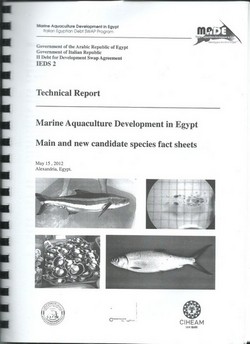
Marine Aquaculture Development in Egypt
Italian Egyptian Debt SWAP Program
Technical Report
Marine Aquaculture Development in Egypt
Main and new candidate species fact sheets
May15.2012, Alexandria, Egypt.
Introduction
1 - Main consideration regarding marine aquaculture in Egypt
One of the main constraint affecting this study, is the possibility to find good aquaculture sites for cage farming along the Mediterranean coast, obtaining the permission from the competent authority, while at the same time not being areas excessively exposed to waves and tides.
Inland aquaculture is already quite developed in Egypt, but improving water qualities (like heavy metals concentration, pollution) and the need to expand production to provide fish for the national market in a context of fast increasing population, requires new production spaces.
The Mediterranean side is mainly excessively exposed to water dynamics and only few locations seem to have real potential.
The Red Sea and Suez Gulf could offer more suitable locations thus have to be carefully excluded protected reefs and tourism interested areas.
There are other solutions, as to prepare earthen ponds with salt water (from well-point or by channel from the sea), thus avoiding part of bureaucratic constraints. Such a solution can be carefully considered especially for the Mediterranean side, where high hydro-dynamism will affect cage structures resistance, and where grounds beyond the shoreline are not used for agriculture because of the high content of salt in the water.
2 - Environmental constrains
Depending on pond management, culture density, feed rate, and water exchange rates, the aquaculture production in ponds may result in water quality issues and excess nutrient loading in the effluent. Large-scale production of fish at various life stages could potentially impact any coastal areas where such activities are located.
Coastal and offshore cage systems, can also determine some form of environmental impact such as disease transmission, nutrient loading around farm sites and escapees (genetic pollution).
Expansion of cage culture in areas such the Red Sea, where cage sites may be close to sensitive coral reef would also require to monitor impacts and the nutrient loading of the nearby ecosystem.
Cage culture environmental impacts are site-specific and, while water exchange rates and dilution factors in many areas are sufficient to prevent excess nutrient loading, each site has a carrying capacity that needs to be considered.
Contents
<!--Introduction
<!--[if !supportLists]--> 2 - Methodology
<!--[if !supportLists]--> 3 - Mediterranean
<!--[if !supportLists]--> 4 - Red Sea
<!--[if !supportLists]--> 5 - Selected Species
<!--Non fin fish
<!--[if !supportLists]--> 7 - Prioritary selected species justification
<!--[if !supportLists]--> 8 - Prevention from animals that can damage cages



ساحة النقاش